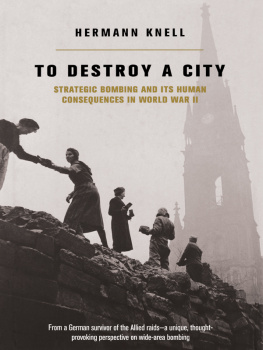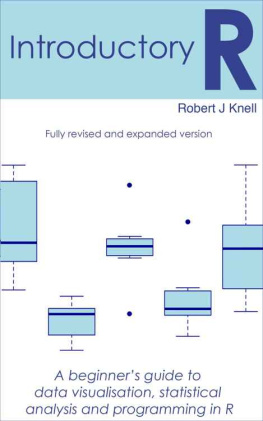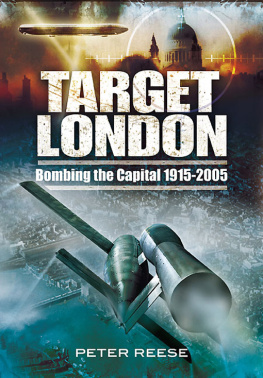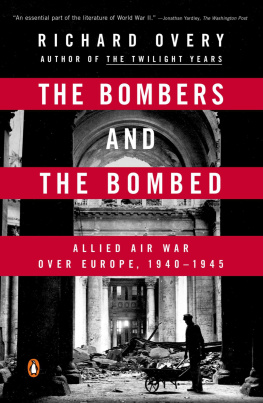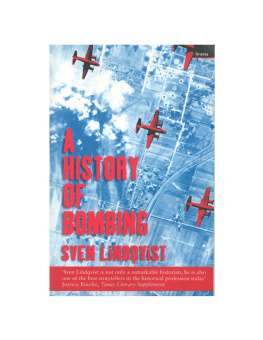To Destroy a City
To Destroy a City
Strategic Bombing and Its Human
Consequences in World War II
Hermann Knell

Published by Da Capo Press
A Member of the Perseus Books Group
http://www.dacapopress.com
Copyright 2003 by Hermann Knell
All rights reserved. No part of this publication may be reproduced, stored in a retrieval system, or transmitted, in any form or by any means, electronic, mechanical, photocopying, recording, or otherwise, without the prior written permission of the publisher.
Typeset and designed by K & P Publishing
Cataloging-in-Publication data for this book is available from the Library of Congress.
ISBN 0-306-81169-3
eBook ISBN: 9780786748495
Da Capo Press books are available at special discounts for bulk purchases in the U.S. by corporations, institutions, and other organizations. For more information, please contact the Special Markets Department at the Perseus Books Group, 11 Cambridge Center, Cambridge, MA 02142, or call (617) 252-5298.
First edition, first printing.
1 2 3 4 5 6 7 8 907 06 05 04 03
Printed and Bound in the United States of America.
ABBREVIATIONS
| ACPS | American Commission for the Protection and Salvation of Artistic and Historic Monuments in War Areas |
| AFSHRC | Albert F. Simpson Historical Research Centre, Montgomery, Alabama |
| AWDP | Air War Division Plan |
| BC | Bomber Command |
| BA | Bundesarchiv, Koblenz |
| BBC | British Broadcasting Corporation |
| BCWD | Bomber Command War Diaries |
| BEF | British Expeditionary Force |
| BMA | Bundesmilitararchiv, Freiburg |
| HE | High Explosive |
| HMSO | His/Her Majesty Stationary Office |
| IAF | Independent Air Force |
| KAGOHL | Kampfgeschwader Oberste Heeresleitung, bomber squadron German Supreme Command |
| LC | Library of Congress, Washington, D.C. |
| LMF | Lack of Moral Fiber |
| LW | Luftwaffe |
| MEW | Ministry of Economic Warfare |
| MP | Member of Parliament |
| NA | National Archives, College Park, Maryland |
| NSDAP | Nationalsozialistische Deutsche Arbeiter Partei |
| NWAAF | North West Army Air Force |
| ORB | Operational Record Book |
| PRO | Public Record Office, London |
| RA | Regia Aeronautica |
| RAF | Royal Air Force |
| RFC | Royal Flying Corps |
| RN | Royal Navy |
| RNAS | Royal Navy Air Service |
| SHAEF | Supreme Headquarters Allied Expeditionary Force |
| SOAG | Strategic Air Offensive against Germany |
| ToT | Time over Target |
| USAAF | United States Army Air Force |
| USTAAF | United States Tactical Army Air Force |
| VE | Victory in Europe Day |
| VJ | Victory in Japan Day |
| WWI | World War I |
| WWII | World War II |
ACKNOWLEDGEMENTS
The writing of this book would not have been possible without the generous and intensive assistance of many people and institutions. It is my pleasure and duty to thank them here.
The collection of information and data started in libraries. The West Vancouver Library with its excellent computer system and its supportive staff was the beginning. In particular I want to thank Mr. Steven Williams who performed miracles in obtaining relevant titles through inter-library loans. From West Vancouver, I moved on to the libraries of Vancouver, the Royal Roads Military College, the University of British Columbia, the New York Public Library, the Bundeswehr Library at Dresden, the Wrzburg University Library, and the Air University Library on Maxwell Air Force Base at Montgomery, Alabama. A special thanks goes to Mrs. Silvia Geissler at Dresden who dug up many publications of great value. The staffs of all the libraries supported me and my work and helped me to find my way through the reference and computer systems. My sincere thanks go to them.
Simultaneously, I visited archives, where again the staffs and the reference systems offered enormous help. It started at the Bundes Militar Archiv at Freiburg, Germany, where Mrs. Scholl and Mr. Moritz steered me onto the most efficient path for archival research. There followed many visits and weeks of studies at the Stadtarchiv and Staatsarchiv at Wrzburg, the Public Record Office in London, the Bundes Archiv at Koblenz, the Humboldt University Archiv in Berlin, Stadt and Technische Hochschule Archives at Darmstadt, the National Archives of Canada in Ottawa, the Library of Congress in Washington, D.C., the National Archives at College Park, Maryland, and the Albert F. Simpson Historical Research Centre on Maxwell Air Force Base, Montgomery, Alabama. Of particular help was Mrs. Ann Webb at the AFSHRC. My thanks to her and the staffs of all the archives.
In collecting information I enjoyed the help of relatives and friends as my daughter Eva, my brother Dieter, and Messrs. Klaus Voss and Bruno Walther and Mrs. Helmes and Mrs. Siebert.
Once I had produced the manuscript I had friends review and edit it. I am grateful for the improvments made by Messrs. George Sharp, William McCorquodale, Philip Pinkus, and Patrick Taylor.
Mr. Leon Krawczyk helped me in recording the illustrations.
At times it was hard work but the help of all the people mentioned above made it possible.
Hermann Knell
October 2002
PREFACE
M any books have been written about aerial warfare since its start in World War I, with authors who are historians, academicians, commanding officers, and airmen. The subjects cover fighter combat, reconnaissance, tactical and strategic bombing. There are accounts of personal experiences, biographies of flying aces, complete histories of campaigns, and in many books an evaluation of the circumstances of the fighting from the technical and historical points of view. The books published on strategic bombing cover its questionable success, its use by the military, and its appalling consequences for civilians. Up to World War II the sufferings of civilians under this method of warfare were acute, but by comparison with what happened after September 1939, relatively small. It was in World War II that bomber raids were flown in ever-increasing numbers causing the deaths of more than 1 million civilians who could not defend themselves.
International literature has many books on the bombings of Hiroshima and Dresden, generally considered the most destructive that ever happened. Little has been written about Nagasaki, or the worst raid in terms of human losses, the Tokyo raid of 9-10 March 1945. Many people think that Dresden and Hamburg were the most destroyed cities in Germany. But the British and U.S. bombing surveys prepared after World War II tell us that Wesel, a city of 25,000 inhabitants, Wuppertal-Elberfeld with over 400,000 inhabitants, and Wrzburg with 107,000 inhabitants, were 97 percent, 94 percent, and 89 percent destroyed, respectively. They were the three most ravaged cities in Europe. Yet one has to search intensely beyond the local libraries to find any publications on these particular human tragedies.

